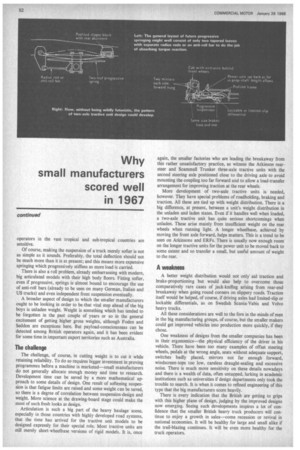Why small manufacturers scored well in 1967
Page 54

If you've noticed an error in this article please click here to report it so we can fix it.
continued operators in the vast tropical and sub-tropical countries are sensitive.
Of course, making the suspension of a truck merely softer is not as simple as it sounds. Preferably, the total deflection should not be much more than it is at present; and this means more expensive springing which progressively stiffens as more load is carried.
There is also a roll problem, already embarrassing with modern, big articulated models with their high body floors. Fitting softer, even if progressive, springs is almost bound to encourage the use of anti-roll bars (already to be seen on many German, Italian and US trucks) and even independent front suspension eventually.
A broader aspect of design to which the smaller manufacturers ought to be looking in order to be.that vital step ahead of the big boys is unladen weight. Weight is something which has tended to be forgotten in the past couple of years or so in the general excitement of getting higher gross weights, although Foden and Seddon are exceptions here. But payload-consciousness can be detected among British operators again, and it has been evident for some time in important export territories such as Australia.
The challenge
The challenge, of course, in cutting weight is to cut it while retaining reliability. To do so requires bigger investment in proving programmes before a machine is marketed—small manufacturers do not generally allocate enough money and time to research. Development time can be saved by a more mathematical approach to some details of design. One result of softening suspension is that fatigue limits are raised and some weight can be saved, so there is a degree of correlation between suspension-design and weight. More science at the drawing-board stage could make the most of such fresh looks at design.
Articulation is such a big part of the heavy haulage scene, especially in those countries with highly developed road systems, that the time has arrived for the tractive unit models to be designed expressly for their special role. Most tractive units are still merely short-wheelbase versions of rigid models. It is, once again, the smaller factories who are leading the breakaway from this rather unsatisfactory practice, as witness the Atkinson rearsteer and Scammell Trunker three-axle tractive units with the second steering axle positioned close to the driving axle to avoid mounting the coupling too far forward and to allow a load-transfer arrangement for improving traction at the rear wheels.
More development of two-axle tractive units is needed, however. They have special problems of roadholding, braking and traction. All these are tied up with weight distribution. There is a big difference, at present, between a unit's weight distribution in the unladen and laden states. Even if it handles well when loaded, a two-axle tractive unit has quite serious shortcomings when unladen. These arise mainly from insufficient weight on the rear wheels when running light. A longer wheelbase, achieved by moving the front axle forward, helps matters. This is a trend to be seen on Atkinsons and ERFs. There is usually now enough room' on the longer tractive units for the power unit to be moved back to some extent and so transfer a small, but useful amount of weight to the rear.
A weelmess
A better weight distribution would not only aid traction and brake-proportioning but would also help to overcome those comparatively rare cases of jack-knifing arising from rear-end breakaway when going round corners on slippery roads. Traction itself would be helped, of course, if driving axles had limited-slip or lockable differentials, as on Swedish Scania-Vabis and Volvo heavy trucks.
All these considerations are well to the fore in the minds of men in the big manufacturing groups, of course, but the smaller makers could get improved vehicles into production more quickly, if they chose.
One weakness of designs from the smaller companies has been in their ergonomics—the physical efficiency of the driver in his vehicle. There have been too many examples of offset steering wheels, pedals at the wrong angle, seats without adequate support, switches badly placed, mirrors not far enough forward, windscreen-tops too low, careless draught-sealing and excessive noise. There is much more sensitivity on these details nowadays and there is a wealth of data, often untapped, lurking in academic institutions such as universities if design departments only took the trouble to search. It is when it comes to refined engineering of this type that the big manufacturers score heavily.
There is every indication that the British are getting to grips with this higher plane of design, judging by the improved designs now emerging. Seeing such developments inspires a lot of confidence that the smaller British heavy truck producers will continue to enjoy a growth in sales—come recession or revival in national economies. It will be healthy for large and small alike if the trail-blazing continues. It will be even more healthy for the truck operators.












































































































